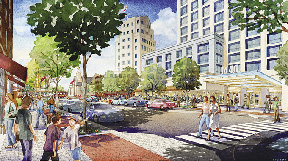When Thomas Koch, mayor of Quincy, announced in 2009 a $1.2 billion plan to renovate downtown Quincy, he and the project's master developer, New York-based Street-Works LLC, promised a dynamic master plan with an aggressive implementation schedule. Following through on their pledge, the City of Quincy and the Street-Works team formalized the master agreement referred to as the Land Disposition Agreement (LDA) in December 2010, setting in motion the long sought redevelopment of the 113 acre downtown commercial district.
The Quincy City Council voted 8-0 in its last session of 2010 to support the Land Disposition Agreement, establishing the legal and financial terms for a plan that calls for more than one million s/f of new office space, two hotels, 570,000 s/f of new retail and restaurant space, more than 1,100 housing units, and five consumer-oriented garages - all four or five stories each. Street-Works also anticipates a wellness center featuring a gym and medical facilities, as well as a cinema and entertainment center.
The downtown development project will be anchored by new and renovated office buildings, including a new building along Hancock St. that could reach 20 stories. The downtown area will feature sidewalk level retail stores and restaurants, and the sidewalks will be widened to between 18 and 20 ft. in order to accommodate open cafes. The entire downtown area will be lined with mature trees.
In addition to the $1.2 billion in private investment, the project will require about $277 million in public infrastructure improvements, including replacing or upgrading utility lines, sewer lines and other infrastructure components. The city and Street-Works are working to secure $50 million in state and federal grant funds for a portion of the improvements, with the remainder to be financed by new taxes and parking revenue from the downtown project.
A crucial feature of the downtown development project is the Quincy Concourse, a long-awaited east-west thoroughfare that will allow motorists to drive between Rte. 3A and the Burgin Pkwy. without having an impact on the street network within Quincy Center. Phase III of the Concourse entailing the reconstruction of McGrath Hwy. and the removal of all overhead utilities lines was completed in early 2010, and is being used today.
The design and construction of Phase II of the Quincy Center Concourse (Hancock St. crossing - final phase) is under construction as a result of $8.1 million in Stimulus funding recently awarded to the project by Governor Deval Patrick and former Congressman William Delahunt. A major portion of the new boulevard is currently being utilized and the entire roadway will be open to all traffic by the end of 2011.
In unison with the completion of the Quincy Center Concourse the city engaged the services of Boston-based Halvorson Design Partnership to develop a schematic design for Adams Green, the open space lynchpin for downtown Quincy's sweeping redevelopment.
Adams Green and its associated public improvements will return to Quincy Center some of the qualities that existed here centuries ago, when the town's Training Field stood adjacent to the United First Parish Church. But the park will be unmistakably contemporary as well, creating a vibrant, convivial public place and a truly superior pedestrian environment that encourages walking and using transit.
The largest gathering space in the park will be the new "town green." It will be located between the entrance to the Quincy Center Red Line/Commuter Rail station, old and new city halls and the point at which Hancock St. will curve into Washington St. The former surface of Hancock St. will be replaced by two adjacent straight pedestrian paths, separated by a series of grassy rectangles. This "promenade" corridor will be lined with trees, flowering plants and benches, and will provide safe and convenient access to three of the city's most important historic sites: United First Parish Church (burial place of Presidents John Adams and John Quincy Adams and their wives, Abigail and Louisa), Old City Hall and historic Hancock Cemetery.
At the southern end of Adams Green, across from the striking art deco architecture of the Granite Trust Building, the schematic plans show the creation of widened sidewalks and a pedestrian plaza to create a "sense of place" in the downtown for this location where five streets converge. This important location is also the point of connection between Adams Green and the $1.2 billion urban redevelopment project.
A recent Economic Impact Report conducted on the project by AKRF Inc. of New York identified the creation of 4,319 full and part-time jobs in the city center, with the addition of over 3,800 construction jobs. A recent agreement between the city and Street-Works will designate that 25% of the construction jobs will be given to workers that live in the city of Quincy. The report further identifies about $10.4 million in new property tax revenues for the city, and several million dollars in secondary spending that typically results in a project of this magnitude.
Street-Works, formed in the 1990s, is both a developer and a consultant to other developers. The company has completed major urban redesign projects from coast to coast, and prides itself on creating attractive, pedestrian-friendly downtown areas that attract residents, shoppers and employers. Some of their signature projects include the $285 million Blue Back Square redevelopment in West Hartford, Conn.; a $200 million project in Bethesda, Md.; a $750 million project in San Jose, Calif. and a $200 million project in New Rochelle, N.Y.
Clearly the city of Quincy is on the move and the revitalization of its downtown commercial center is a priority for community and state leaders. The city takes great stock in its tremendous assets and is exhibiting leadership and vision as it strives to establish a 21st Century city that is reinvigorated physically, socially and economically.
The city welcomes the opportunity to boast of these exciting initiatives to promote new investment opportunities within our rejuvenated downtown and that place high value on protecting the public realm, preserving history and fostering sustainable development practices. Whether a company requires public transportation, a deep sea port, commercial rail, a beautiful waterfront, access to major highways, proximity to Boston, a quality workforce or a diversified community - Quincy is the place to live, work and invest in. Quincy 2000 Collaborative, a division of the Quincy Chamber of Commerce, and the city administration are eager to convince you that here in Quincy We Mean Business!
Dean Rizzo is executive director of Quincy 2000 Collaborative, Quincy, Mass.
Tags:










